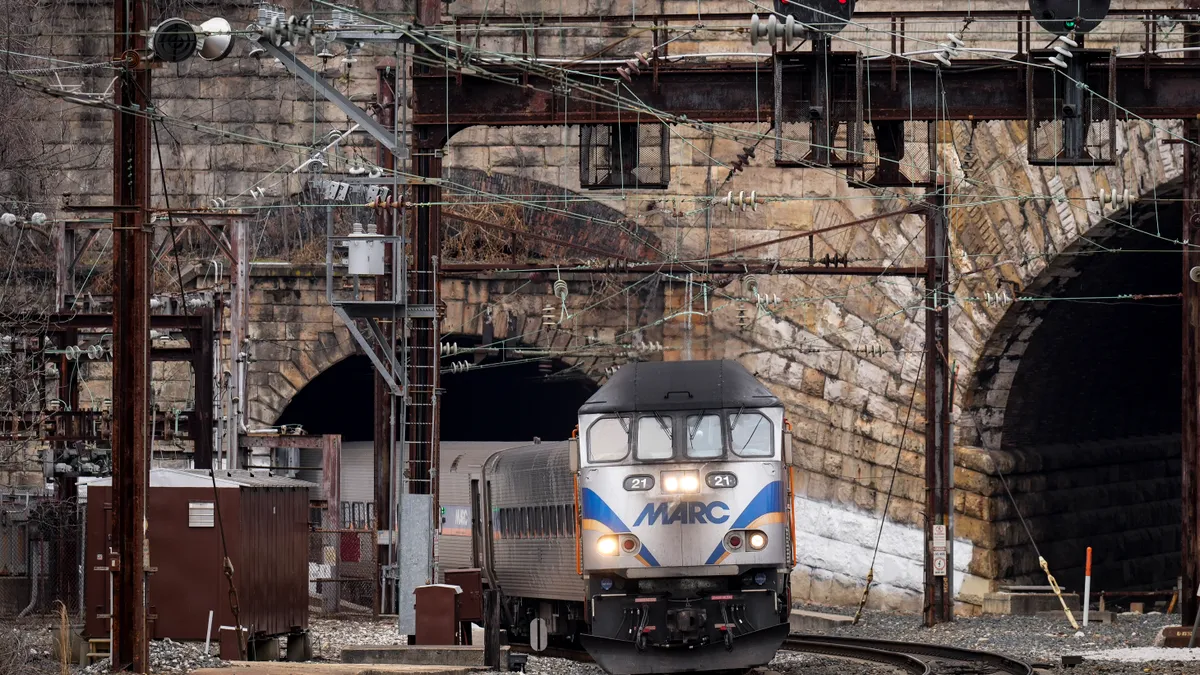Dive Brief:
- President Joe Biden drew national attention to a crumbling railway tunnel in Baltimore during a visit Monday to tout the Infrastructure Investment and Jobs Act.
- The 150-year-old Baltimore and Potomac Tunnel is the largest rail bottleneck between Washington, D.C., and New Jersey, according to the White House. The 1.4-mile, two-track tunnel is one of the oldest structures in the Northeast Corridor and among the most heavily used, carrying passengers by Amtrak and regional rails as well as freight.
- To replace the B&P, Amtrak is soliciting partners to build a new $4.5 billion tunnel that will be named after Civil War abolitionist and statesman Frederick Douglass.
Dive Insight:
As Biden noted on Monday, the B&P tunnel is falling apart. Because of crumbling brick and sinking floor slabs, passenger trains are slowed to 30 mph when passing through. It’s also the only point along the Northeast Corridor where both tracks rely on a single structure, so there’s no detour option if the tunnel has to unexpectedly close.
“It’s currently the biggest bottleneck holding back high-speed rail and passenger service” in the Northeast Corridor, said Kathy Hollinger, CEO at the Greater Washington Partnership, a regional civic alliance. Enabling better movement within the region will make it more economically competitive, and a new, electrified tunnel “will be transformative not just for Baltimore City but for the entire East Coast.”
The new Frederick Douglass Tunnel, located northwest of the current tunnel, will have two single-track, high-capacity twin tubes and take over the bulk of the B&P Tunnel traffic. These twin tubes will enable the travel of electric Amtrak and MARC trains up to 100 mph. The project also includes the addition of modern fire and safety systems, such as emergency egress pathways and ventilation systems.
The new tunnel will start carrying passengers in 2032, according to Amtrak, and diesel-powered freight trains will continue to use the old tunnel about four times a week.
Work has kicked off with the first phase of the $1 billion Southern Approach, which includes a new ADA-compliant West Baltimore MARC station, major excavations for the approach to the south portal for the new tunnel and bridge construction, plus utility and roadway work.
Amtrak is paying for some of the work, with other funding from the state of Maryland, Amtrak and the federal government through the Federal Rail Administration.
No money has come from the Infrastructure Investment and Jobs Act yet, Beth Toll, Amtrak senior public relations manager, told Construction Dive in an email, but Amtrak intends to apply for IIJA funds through the Northeast Corridor Federal-State Partnership for Intercity Passenger Rail Program.
Seeking a delivery partner
To build this project, Amtrak is using multiple delivery methods, including the Delivery Partner model, where a construction partner’s payments will be tied to key metrics. By meeting specific milestones, the partner can increase its own profits — or take a hit if it doesn’t. The partner will be paid overhead costs and a fixed fee over the life of the project.
Amtrak sees the Delivery Partner model as a way to share risk with a private partner and as a compliment to using the Construction Manager At Risk delivery method, Toll said. It’s the first time Amtrak is also using the CMAR model.
“In an effort to better leverage early engagement from industry, increase the opportunity for innovation, and reduce cost and schedule risk, Amtrak will be using more alternative delivery methods to complete its capital works,” said Toll. “Utilizing CMAR and other alternative delivery methods will create more certainty of outcome.”
A CMAR arrangement allows for effective cost management, according to Neil R. Shulman, adjunct professor in construction management and engineering at the University of Maryland Clark School of Engineering. Change orders aren’t eliminated but are more likely to be reduced because the builder is involved early in the process.
“The builder can go through the constructability analysis and really try to keep the architect and engineer in line,” Shulman said.
Amtrak launched solicitation for the Delivery Partner in June 2022, and it said more than two dozen firms responded to the initial delivery partner RFI. The rail company was expected to release the request for proposal to companies it deems eligible in late January.











